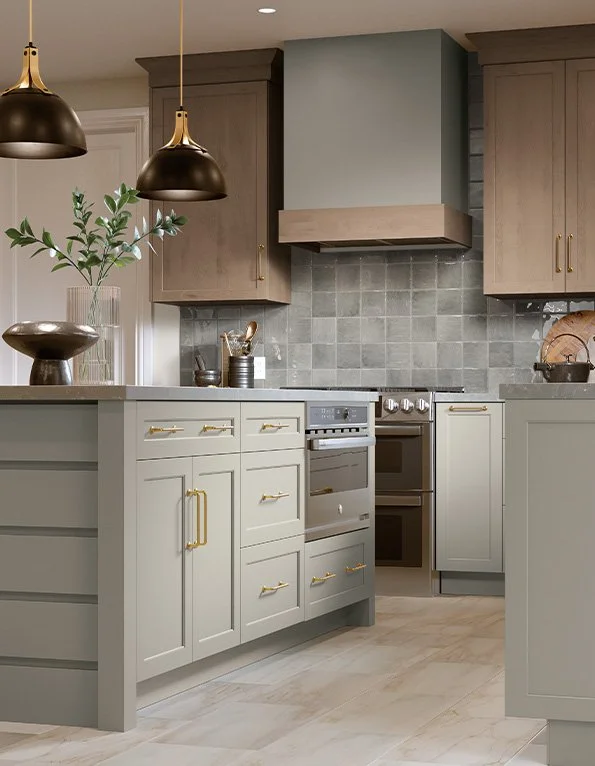Which Wood to Choose When Buying Cabinets
Think of how many times you open your cabinets in a day, and how much of an impact they visually have on your space.
Fieldstone Kitchen, White Oak Natural & Regency Green
Cabinets matter!! In fact, we believe that selecting the right cabinetry is the most important decision when undergoing a kitchen or bathroom renovation or building a new house. Cabinets are integral pieces of our home that are semi-permanent and we rely heavily upon them EVERY SINGLE DAY.
When we work with a client to select cabinetry, one of the first decisions we help them to navigate is which kind of wood to use. Often, clients are drawn to a certain type of wood based upon how it looks, which is certainly one important factor. Many people don’t realize that there are other important factors to consider as well, including the relative hardness (or softness) of the wood, the wood’s propensity for variation in color or grain and the tendencies of the wood to change in appearance with age and light exposure.
The following is a quick guide for what to expect with each of the wood species we offer at Ever After Interiors:
Maple with Mushroom Stain, Fieldstone Cabinetry
Walnut
Walnut Door with Natural Finish, Fieldstone Cabinetry
Black walnut has been called “King of Hardwoods.” It is considered a premium choice for cabinetry and hardwood flooring. It features a smooth grain with a rich, warm appeal. It ranges in color from deep chocolate to light reddish-gray brown. Sapwood will be present and range from light yellow to light brown. As it ages, Walnut will mellow and lighten in color, and take on an orange / yellow cast.
We consistantly advise our clients to expect a lightening in appearance over time, especially if the cabinetry is exposed to direct sunlight.
Alder
Alder with Java glaze, Fieldstone Cabinetry
Even though it is categorized as a hardwood, alder is one of the softest. It features a fine, straight grain and even texture, and some small, tight knots may be present. The color tone is light brown with a yellow or reddish tinge. There isn’t a significant color difference between its heartwood and sapwood. As a result, little variation can be seen in the grain on the cabinet. Alder does not age as quickly or significantly as other species and after many years, the tone tends to remain steady.
We help our clients to understand that if they select alder, extra care must be take to avoid damage due to its softer nature.
Maple
Maple Cloud Tinted Varnish & Maple Boardwalk Stained by Kemper Cabinets
Maple is a versatile hardwood with a fine, smooth grain. It boasts a high level of strength and durability that is attractive for high traffic areas. It varies in color from nearly white to slightly reddish brown. Mineral or sugar streaks occur naturally and can vary from piece to piece. This is more noticeable when a lighter stains is selected. Maple will darken and appear more yellow as it ages. The noticeability of this yellowing varies based upon stain color selected.
We often recommend that our clients use maple if they wish to have a painted finish on hardwood cabinets. We advise our clients that lighter stains on maple can yellow more over time, while darker stains seem to mask the yellowing more.
Oak
White Oak with Natural Stain, Fieldstone Cabinetry
Oak displays telltale cathedral patterns on the face of the board. It is a strong hardwood with a long, linear grain. At times, it has small pinholes and tight knots. Coloration can range from golden blond to deeper orange and red tones.
Quarter sawn oak is milled at an angle 60-90 degrees from the grain. It features a more straight grain, allowing rays and flecks to become visible. This gives the wood unique character and dimension and minimizes any extreme cathedral peaks.
Rift sawn oak is milled perpendicular to the log’s growth rings. This gives it a linear grain pattern with no flecking. Rift sawing leaves the wood with the straightest grain pattern.
We advise our clients that oak has a tendency to become more yellow over time and with light exposure. Like maple, a lighter stain will make this more apparent and a darker stain will tend to mask this tendency.
Cherry
Cherry with Slate Stain, Fieldstone Cabinetry
Cherry displays a distinctive grain pattern and warm color shadings, ranging from nearly white to dark reddish brown. Dark pockets, pin knots and random streaks are common. Cherry is extremely strong and durable and is considered a premium wood for cabinetry. More than most woods, cherry will darken when exposed to light, especially in light stains.
We advise clients to expect a darkening of the cherry wood over time, especially in areas with direct sun exposure.
Hickory
Hickory Door with Natural Stain, Fieldstone Cabinetry
Hickory is a heavy, strong hardwood known for flowing, vibrant grain patterns and dramatic color variation. Hickory can also exhibit random pecks, burls and mineral streaks. Hickory’s color ranges across a wide spectrum, from nearly white to dark brown. It will mellow as it ages, and the drastic color variations will become less apparent.
Hickory is great for high traffic areas! We advise our clients to expect the vibrancy of the color streaks to soften over time.







